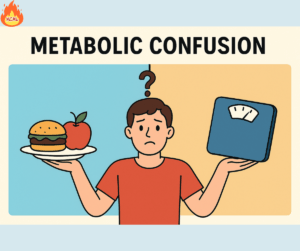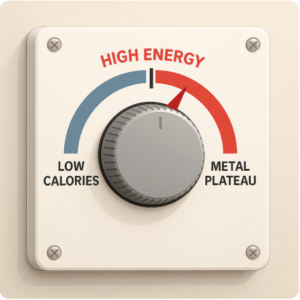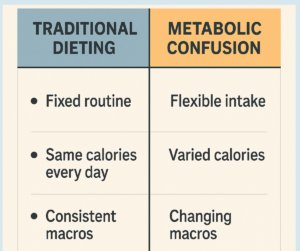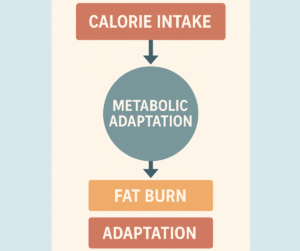Metabolic Confusion: Science, Strategy & Real Talk for Fat Loss

If you’ve ever tried dieting, you know the frustration. The first few pounds melt away, then—nothing. Your body clings to fat like a toddler with a security blanket. Enter metabolic confusion, the buzzy strategy that promises to jolt your metabolism out of autopilot. But is it legit, or just another fleeting trend? Let’s dissect it—no fluff, just facts.
What Exactly Is Metabolic Confusion?
Metabolic confusion (also called calorie cycling or diet cycling) is the dietary equivalent of keeping your body on its toes. Instead of eating the same calories every day, you alternate between high and low intake. Some versions also tweak macronutrients—carbs, fats, proteins—to amplify the effect.
Think of your metabolism like a thermostat. Traditional dieting? It’s like cranking the AC to max and leaving it there. Eventually, your body adjusts. Metabolic confusion? You’re constantly adjusting the temperature—so your metabolism never gets too comfortable.
How It Stacks Up Against Traditional Dieting
Most diets operate like rigid rulebooks:
-
Calorie counting: Same number every day.
-
Macro tracking: Fixed ratios.
-
Predictability: Your body adapts—fast.
Metabolic confusion flips the script. Here’s how:
-
Monday: 1,800 calories, higher carbs (for energy)
-
Tuesday: 1,400 calories, lower carbs (fat-burning mode)
-
Wednesday: 2,000 calories, balanced macros (metabolic reset)
The inconsistency is the strategy. Your body can’t settle into a routine, so it keeps burning calories efficiently.
The Science Behind the Metabolic Confusion Strategy
Your metabolism isn’t static—it’s a dynamic system shaped by evolution. When you slash calories long-term, your body panics. It slows calorie burn to conserve energy—a process known as metabolic adaptation, which is a common reason why weight loss plateaus occur. This is why weight loss plateaus happen.
Metabolic confusion exploits this adaptability. Research suggests intermittent calorie shifts may:
-
Preserve muscle mass (critical for metabolic health)
-
Prevent metabolic slowdown (unlike steady calorie restriction)
-
Enhance fat loss (by keeping the body guessing)
⚠️ Note: Most studies are small or anecdotal. The science isn’t bulletproof—yet.
Does It Work? The Pros and Cons of Metabolic Confusion
✅ Pros
-
Flexibility: No food is off-limits.
-
Psychological relief: High-calorie days feel like a cheat—without guilt.
-
Metabolic benefits: Helps avoid “starvation mode.”
❌ Cons
-
Requires tracking: May feel tedious.
-
Not a miracle: You still need a calorie deficit.
-
Limited research: Less studied than IF or keto.
How to Implement Metabolic Confusion (Without Losing Your Mind)
Want to try it? Here’s how:
-
Calculate maintenance calories using a TDEE calculator.
-
Cycle intake:
-
Low days: 10–20% below maintenance
-
High days: At/above maintenance
-
-
Tweak macros:
-
Higher carbs on training days
-
Lower carbs on rest days
-
-
Check in with yourself:
-
Adjust based on energy, hunger, mood
-
Sample 7-Day Plan
| Day | Calories | Carbs | Activity Level |
|---|---|---|---|
| Monday | 1,600 | Moderate | Yoga/Pilates |
| Tuesday | 2,000 | High | Strength Training |
| Wednesday | 1,400 | Low | Rest Day |
| Thursday | 2,200 | High | HIIT Workout |
| Friday | 1,800 | Moderate | Light Cardio |
| Saturday | 2,000 | High | Active Recovery |
| Sunday | 1,600 | Low | Rest Day |
📌 Customize based on your lifestyle, body type, and energy needs.
Common Pitfalls (And How to Avoid Them)
-
Overthinking it: Start simple. Complexity is optional.
-
Ignoring hunger: If you’re chronically hangry, reassess.
-
Expecting instant results: Metabolic confusion isn’t magic—it’s strategic patience.
The Pop Culture Connection
Metabolic confusion isn’t exactly new. Bodybuilders have been using carb cycling for decades. Even Hollywood leans into it—Hugh Jackman reportedly followed a version for Wolverine.
Unlike celery juice cleanses, this method has some scientific credibility.
Final Verdict: Should You Try It?
Metabolic confusion won’t turn you into Thor—but it’s a flexible, science-informed method that might shake you out of a plateau.
-
Start slow
-
Stay consistent
-
Make it sustainable
Life’s too short for flavorless chicken breast every day. 🍗
Frequently Asked Questions (FAQ)
1. What is metabolic confusion?
It’s a dietary method that alternates calorie or macronutrient intake to keep your metabolism “on its toes” and prevent plateaus.
2. How does it work?
By cycling intake, your body doesn’t adapt to a set routine, which may support fat loss and metabolic health.
3. Who is it for?
Anyone bored with traditional dieting, hitting a plateau, or needing more dietary flexibility.
4. Any risks?
Poor planning can lead to fatigue or overeating. Best to consult a dietitian if you’re unsure.




